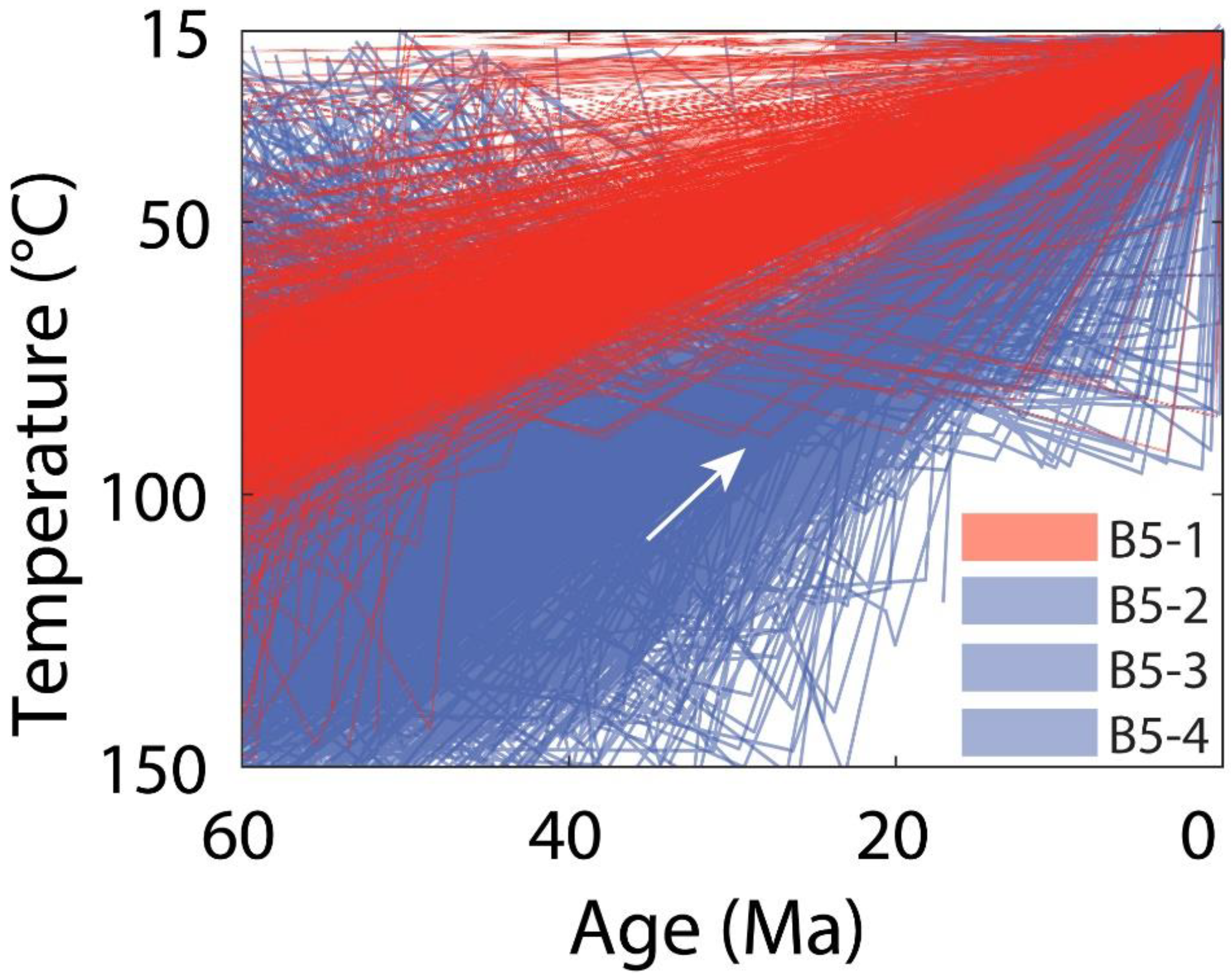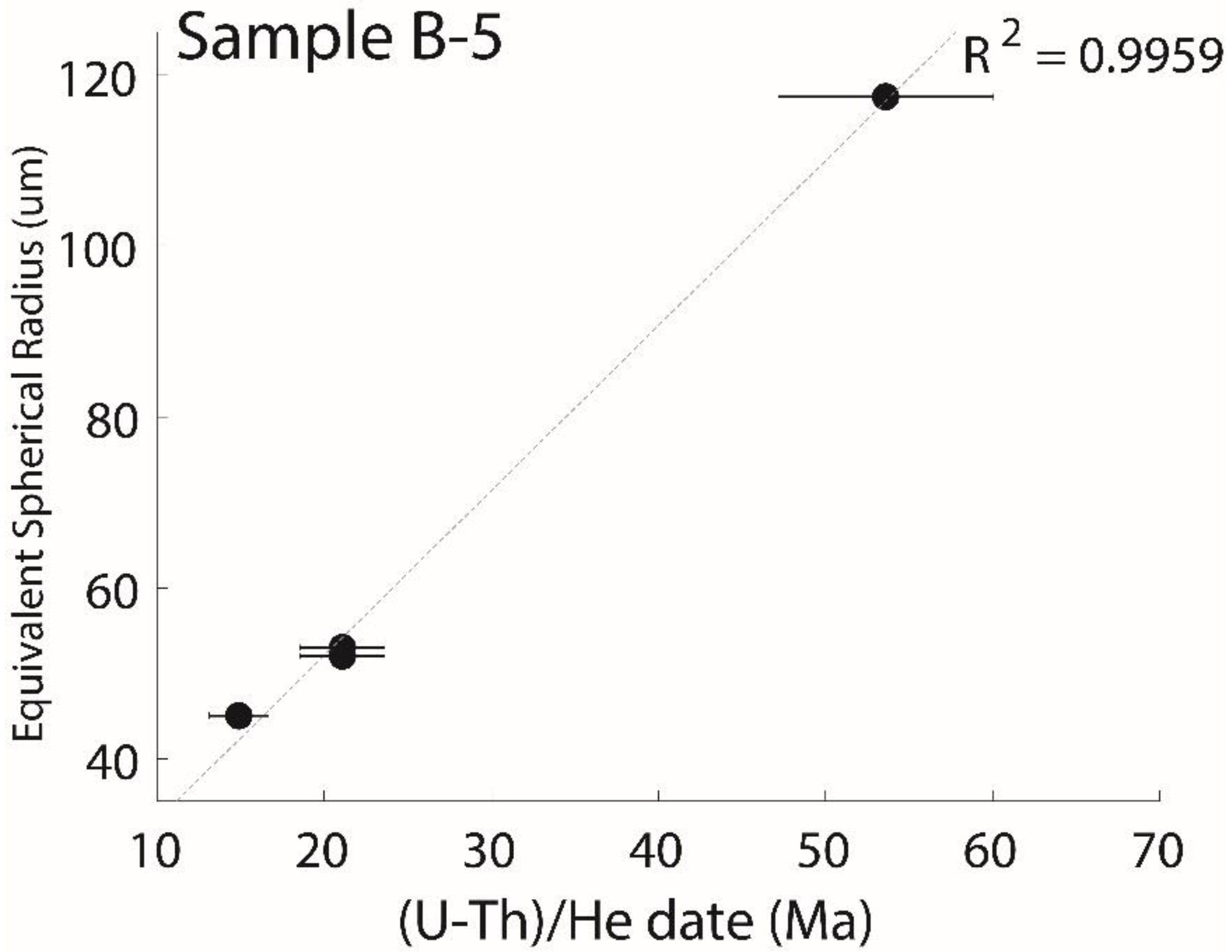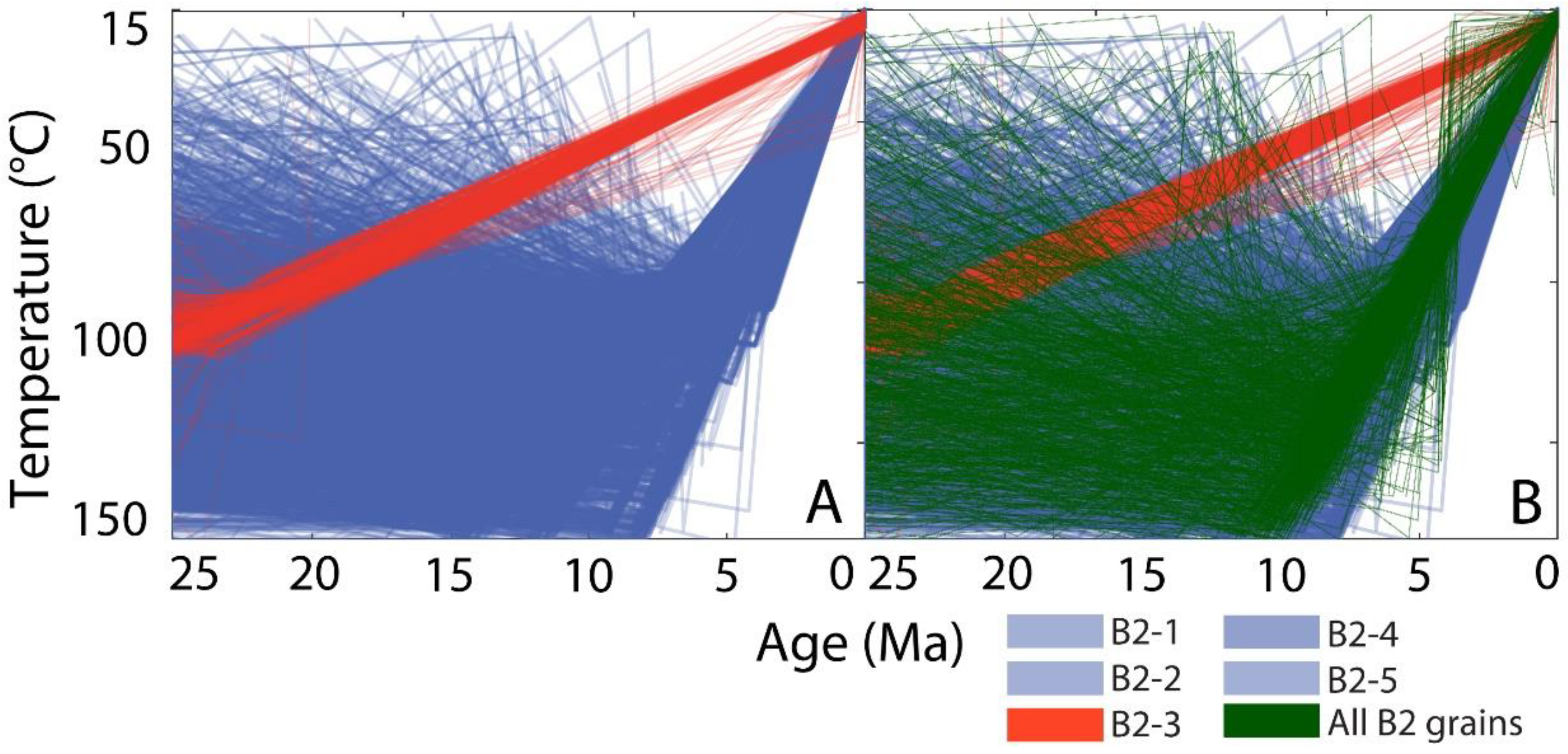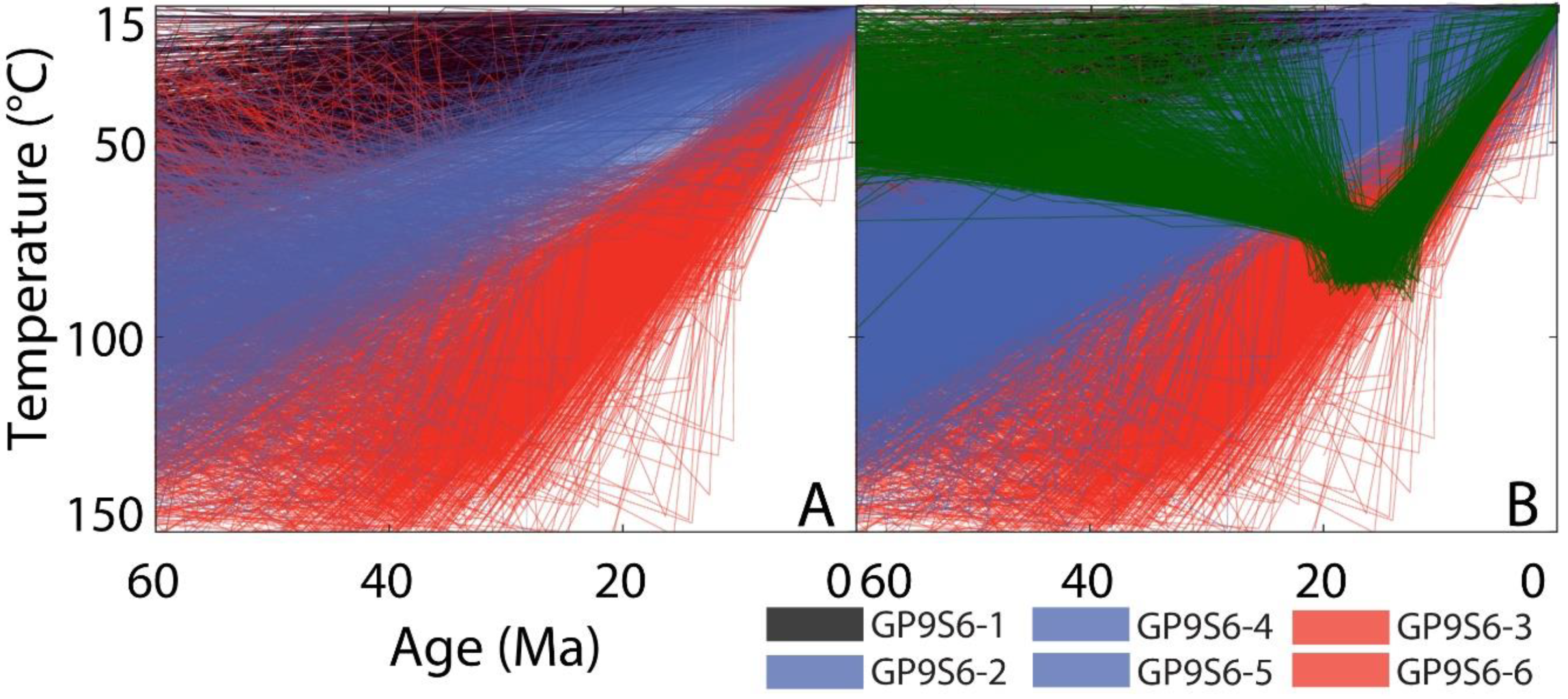A Framework for Evaluating Variation in (U-Th)/He Datasets
Abstract
:1. Introduction
- removal of dates subjectively—this is enforced at the discretion of individual authors and is not necessarily explained. Rejected dates are sometimes attributed to the presence of inclusions, despite screening undertaken to eliminate grains with inclusions.
2. A Framework for Evaluating Variation
- Run an independent model for each (U-Th)/He date.
- Visualize the model outputs for all single grains on a single set of time-temperature axes.
- If all data are compatible, then all variation is legitimate. Move forward with interpretation. Otherwise, illegitimate variation is present, and the sample should be flagged as such. Samples with illegitimate variation will contain less useful thermal history information than those with legitimate variation only. Rejecting a date is acceptable in the case that it is not geologically possible (e.g., if a date is older than a zircon U/Pb formation age of the same igneous sample).
3. Modeling Strategy
4. A Synthetic Example
5. Examining Published (U-Th)/He Data
5.1. Greater Caucasus
5.2. Shillong Plateau (India)
5.3. Western Sierra Nevada Foothills, California
6. Evaluating Variation
6.1. Step One: Single Grain Model Runs
6.2. Step Two: Visualize Single Grain Model Results
6.3. Step Three: Evaluate Legitimacy of Variation Based on Compatibility of Thermal Histories
6.3.1. Erroneous Rejection of Legitimate Data
6.3.2. Rejection of Illegitimate Data
6.4. Additional Examples
6.4.1. Disparate Dates
6.4.2. Legitimate Variation
7. Discussion
7.1. Modeling Strategy
7.2. Interpreting Dates
8. Conclusions
- Model each individual grain independently. Employ the principle of minimum necessary constraint (MNC).
- Visualize the acceptable thermal histories of each grain together on a single set of time-temperature axes.
- Decide whether variation amongst individual dates is legitimate by considering the compatibility amongst allowable thermal histories of each date. Flag illegitimate samples.
Author Contributions
Funding
Acknowledgments
Conflicts of Interest
References
- Gallagher, K. Transdimensional inverse thermal history modeling for quantitative thermochronology. J. Geophys. Res. Solid Earth 2012, 117, B02408. [Google Scholar] [CrossRef] [Green Version]
- Flowers, R.M.; Ketcham, R.A.; Shuster, D.L.; Farley, K.A. Apatite (U–Th)/He thermochronometry using a radiation damage accumulation and annealing model. Geochim. Cosmochim. Acta 2009, 73, 2347–2365. [Google Scholar] [CrossRef]
- Farley, K.A. (U-Th)/He dating: Techniques, calibrations, and applications. Rev. Mineral. Geochem. 2002, 47, 819–844. [Google Scholar] [CrossRef]
- Ehlers, T.A.; Farley, K.A. Apatite (U–Th)/He thermochronometry: Methods and applications to problems in tectonic and surface processes. Earth Planet. Sci. Lett. 2003, 206, 1–14. [Google Scholar] [CrossRef]
- Reiners, P.W.; Ehlers, T.A.; Zeitler, P.K. Past, present, and future of thermochronology. Rev. Mineral. Geochem. 2005, 58, 1–18. [Google Scholar] [CrossRef] [Green Version]
- Wolf, R.A.; Farley, K.A.; Silver, L.T. Helium diffusion and low temperature thermochronometry of apatite. Geochim. Cosmochim. Acta 1996, 60, 4231–4240. [Google Scholar] [CrossRef]
- House, M.A.; Wernicke, B.P.; Farley, K.A.; Dumitru, T.A. Cenozoic thermal evolution of the central Sierra Nevada, California, from (UTh)/He thermochronometry. Earth Planet. Sci. Lett. 1997, 151, 167–179. [Google Scholar] [CrossRef]
- Zeitler, P.K.; Herczeg, A.L.; McDougall, I.; Honda, M. U-Th-He dating of apatite: A potential thermochronometer. Geochim. Cosmochim. Acta 1987, 51, 2865–2868. [Google Scholar] [CrossRef]
- House, M.A.; Farley, K.A.; Stockli, D. Helium chronometry of apatite and titanite using Nd-YAG laser heating. Earth Planet. Sci. Lett. 2000, 183, 365–368. [Google Scholar] [CrossRef]
- Reiners, P.W.; Ehlers, T.A.; Garveer, J.I.; Mitchell, S.G.; Montgomery, D.R.; Vance, J.A.; Nicolescu, S. Late Miocene exhumation and uplift of the Washington Cascade Range. Geology 2002, 30, 767–770. [Google Scholar] [CrossRef] [Green Version]
- Stockli, D.F.; Dumitru, T.A.; McWilliams, M.O.; Farley, K.A. Cenozoic tectonic evolution of the White Mountains, California and Nevada. Geol. Soc. Am. Bull. 2003, 115, 788–816. [Google Scholar] [CrossRef]
- Staisch, L.M.; Niemi, N.A.; Clark, M.K.; Chang, H. Eocene to late Oligocene history of crustal shortening within the Hoh Xil Basin and implications for the uplift history of the northern Tibetan Plateau. Tectonics 2016, 35, 862–895. [Google Scholar] [CrossRef] [Green Version]
- Biswas, S.; Coutand, I.; Grujic, D.; Hager, C.; Stockli, D.; Grasemann, B. Exhumation and uplift of the Shillong plateau and its influence on the eastern Himalayas: New constraints from apatite and zircon (U-Th-[Sm])/He and apatite fission track analyses. Tectonics 2007, 26, TC6013. [Google Scholar] [CrossRef]
- Avdeev, B.; Niemi, N.A. Rapid Pliocene exhumation of the central Greater Caucasus constrained by low-temperature thermochronometry. Tectonics 2011, 30, TC2009. [Google Scholar] [CrossRef] [Green Version]
- Sousa, F.J.; Saleeby, J.; Farley, K.A.; Unruh, J.R.; Lloyd, M.K. The southern Sierra Nevada pediment, central California. Geosphere 2017, 13, 82–101. [Google Scholar] [CrossRef]
- Reiners, P.W.; Farley, K.A.; Hickes, H.J. He diffusion and (U–Th)/He thermochronometry of zircon: Initial results from Fish Canyon Tuff and Gold Butte. Tectonophysics 2002, 349, 297–308. [Google Scholar] [CrossRef]
- Reiners, P.W.; Spell, T.L.; Nicolescu, S.; Zanetti, K.A. Zircon (U-Th)/He thermochronometry: He diffusion and comparisons with 40Ar/39Ar dating. Geochim. Cosmochim. Acta 2004, 68, 1857–1887. [Google Scholar] [CrossRef]
- Dodson, M.H. Closure temperature in cooling geochronological and petrological systems. Contrib. Mineral. Petrol. 1973, 40, 259–274. [Google Scholar] [CrossRef]
- Farley, K.A. Helium diffusion from apatite: General behaviors as illustrated by Durango fluorapatite. J. Geophys. Res. 2000, 105, 2903–2914. [Google Scholar] [CrossRef] [Green Version]
- Gerin, C.; Gautheron, C.; Oliviero, E.; Bachelet, C.; Djimbi, D.M.; Seydoux-Guillaume, A.M.; Tassan-Got, L.; Sarda, P.; Roques, J.; Garrido, F. Influence of vacancy damage on He diffusion in apatite, investigated at atomic to mineralogical scales. Geochim. Cosmochim. Acta 2017, 197, 87–103. [Google Scholar] [CrossRef]
- Flowers, R.M.; Kelley, S.A. Interpreting data dispersion and “inverted” dates in apatite (U–Th)/He and fission-track datasets: An example from the US midcontinent. Geochim. Cosmochim. Acta 2011, 75, 5169–5186. [Google Scholar] [CrossRef]
- Shuster, D.L.; Flowers, R.M.; Farley, K.A. The influence of natural radiation damage on helium diffusion kinetics in apatite. Earth Planet. Sci. Lett. 2006, 249, 148–161. [Google Scholar] [CrossRef]
- Warnock, A.C.; Zeitler, P.K.; Wolf, R.A.; Bergman, S.C. An evaluation of low-temperature apatite U Th/He thermochronometry. Geochim. Cosmochim. Acta 1997, 61, 5371–5377. [Google Scholar] [CrossRef]
- Recanati, A.; Gautheron, C.; Barbarand, J.; Missenard, Y.; Pinna-Jamme, R.; Tassan-Got, L.; Carter, A.; Douville, E.; Bordier, L.; Pagel, M.; et al. Helium trapping in apatite damage: Insights from (U-Th-Sm)/He dating of different granitoid lithologies. Chem. Geol. 2017, 470, 116–131. [Google Scholar] [CrossRef] [Green Version]
- McDannell, K.T.; Zeitler, P.K.; Janes, D.G.; Idleman, B.D.; Fayon, A.K. Screening apatites for (U-Th)/He thermochronometry via continuous ramped heating: He age components and implications for age dispersion. Geochim. Cosmochim. Acta 2018, 223, 90–106. [Google Scholar] [CrossRef]
- Cooperdock, E.H.G.; Ketcham, R.A.; Stockli, D.F. Resolving the effects of 2-D versus 3-D grain measurements on apatite (U–Th)/He age data and reproducibility. Geochronology 2019, 1, 17–41. [Google Scholar] [CrossRef] [Green Version]
- Gautheron, C.; Tassan-Got, L.; Ketcham, R.A.; Dobson, K.J. Accounting for long alpha-particle stopping distances in (U–Th–Sm)/He geochronology: 3D modeling of diffusion, zoning, implantation, and abrasion. Geochim. Cosmochim. Acta 2012, 96, 44–56. [Google Scholar] [CrossRef] [Green Version]
- Farley, K.A.; Shuster, D.L.; Ketcham, R.A. U and Th zonation in apatite observed by laser ablation ICPMS, and implications for the (U–Th)/He system. Geochim. Cosmochim. Acta 2011, 75, 4515–4530. [Google Scholar] [CrossRef]
- Gautheron, C.; Tassan-Got, L.; Barbarand, J.; Pagel, M. Effect of alpha-damage annealing on apatite (U–Th)/He thermochronology. Chem. Geol. 2009, 266, 157–170. [Google Scholar] [CrossRef]
- Wolf, R.A.; Farley, K.A.; Silver, L.T. Assessment of (U-Th)/He thermochronometry: The low-temperature history of the San Jacinto mountains, California. Geology 1997, 25, 65–68. [Google Scholar] [CrossRef]
- Dean, R.B.; Dixon, W.J. Simplified Statistics for Small Numbers of Observations. Anal. Chem. 1951, 23, 636–638. [Google Scholar] [CrossRef]
- Boddy, R.; Smith, G. Effective Experimentation: For Scientists and Technologists; John Wiley & Sons: Hoboken, NJ, USA, 2011. [Google Scholar]
- Ketcham, R.A. Forward and inverse modeling of low-temperature thermochronometry data. Rev. Mineral. Geochem. 2005, 58, 275–314. [Google Scholar] [CrossRef]
- Fox, M.; Carter, A. Heated Topics in Thermochronology and Paths towards Resolution. Geosciences 2020, 10, 375. [Google Scholar] [CrossRef]
- Vermeesch, P.; Tian, Y. Thermal history modelling: HeFTy vs. QTQt. Earth Sci. Rev. 2014, 139, 279–290. [Google Scholar] [CrossRef] [Green Version]
- Vermeesch, P.; Tian, Y. Reply to Comment on “Thermal history modelling: HeFTy vs. QTQt” by K. Gallagher and R.A. Ketcham. Earth Sci. Rev. 2018, 176, 395–396. [Google Scholar] [CrossRef]
- Gallagher, K.; Ketcham, R.A. Comment on “Thermal history modelling: HeFTy vs. QTQt” by Vermeesch and Tian, Earth-Science Reviews (2014), 139, 279–290. Earth Sci. Rev. 2018, 176, 387–394. [Google Scholar] [CrossRef]
- Gallagher, K. Comment on ‘A reporting protocol for thermochronologic modeling illustrated with data from the Grand Canyon’ by Flowers, Farley and Ketcham. Earth Planet. Sci. Lett. 2016, 441, 211–212. [Google Scholar] [CrossRef]
- Flowers, R.M.; Farley, K.A.; Ketcham, R.A. A reporting protocol for thermochronologic modeling illustrated with data from the Grand Canyon. Earth Planet. Sci. Lett. 2015, 432, 425–435. [Google Scholar] [CrossRef] [Green Version]
- Flowers, R.M.; Farley, K.A.; Ketcham, R.A. Response to comment on “A reporting protocol for thermochronologic modeling illustrated with data from the Grand Canyon”. Earth Planet. Sci. Lett. 2016, 441, 213. [Google Scholar] [CrossRef]
- Sousa, F.J. Eocene Origin of Owens Valley, California. Geosciences 2019, 9, 194. [Google Scholar] [CrossRef] [Green Version]
- Gavillot, Y.; Meigs, A.J.; Sousa, F.J.; Stockli, D.; Yule, D.; Malik, M. Late Cenozoic Foreland-to-Hinterland Low-Temperature Exhumation History of the Kashmir Himalaya. Tectonics 2018, 37, 3041–3068. [Google Scholar] [CrossRef]
- Sousa, F.J.; Farley, K.A.; Saleeby, J.; Clark, M. Eocene activity on the Western Sierra Fault System and its role incising Kings Canyon, California. Earth Planet. Sci. Lett. 2016, 439, 29–38. [Google Scholar] [CrossRef] [Green Version]
- Willett, C.D.; Fox, M.; Shuster, D.L. A helium-based model for the effects of radiation damage annealing on helium diffusion kinetics in apatite. Earth Planet. Sci. Lett. 2017, 477, 195–204. [Google Scholar] [CrossRef] [Green Version]
- Ketcham, R.A.; Gautheron, C.; Tassan-Got, L. Accounting for long alpha-particle stopping distances in (U–Th–Sm)/He geochronology: Refinement of the baseline case. Geochim. Cosmochim. Acta 2011, 75, 7779–7791. [Google Scholar] [CrossRef]
- Gautheron, C.; Tassan-Got, L. A Monte Carlo approach to diffusion applied to noble gas/helium thermochronology. Chem. Geol. 2010, 273, 212–224. [Google Scholar] [CrossRef]
- Lossada, A.C.; Giambiagi, L.; Hoke, G.D.; Fitzgerald, P.G.; Creixell, C.; Murillo, I.; Mardonez, D.; Velásquez, R.; Suriano, J. Thermochronologic Evidence for Late Eocene Andean Mountain Building at 30° S. Tectonics 2017, 36, 2693–2713. [Google Scholar] [CrossRef]
- Abbey, A.L.; Niemi, N.A.; Geissman, J.W.; Winkelstern, I.Z.; Heizler, M. Early Cenozoic exhumation and paleotopography in the Arkansas River valley, southern Rocky Mountains, Colorado. Lithosphere 2017, 10, 239–266. [Google Scholar] [CrossRef] [Green Version]
- Abbey, A.L.; Niemi, N.A. Low-temperature thermochronometric constraints on fault initiation and growth in the northern Rio Grande rift, upper Arkansas River valley, Colorado, USA. Geology 2018, 46, 627–630. [Google Scholar] [CrossRef]
- Bateman, P.C.; Busacca, A.J.; Sawka, W.N. Cretaceous Deformation in the Western Foothills of the Sierra-Nevada, California. Geol. Soc. Am. Bull. 1983, 94, 30–42. [Google Scholar] [CrossRef]
- Saleeby, J.; Saleeby, Z.; Sousa, F. From deep to modern time along the western Sierra Nevada Foothills of California, San Joaquin to Kern River drainages. Geol. Soc. Am. Field Guides 2013, 32, 37–62. [Google Scholar] [CrossRef]
- Sousa, F.; Saleeby, J.; Farley, K.A.; Unruh, J. The Southern Sierra Nevada Foothills Bedrock Pediment. In Proceedings of the 2013 GSA Cordilleran Section Meeting, Fresno, CA, USA, 20–22 May 2013; p. 53. [Google Scholar]
- Sousa, F.; Saleeby, J.; Farley, K.A. Chronology of Tectonic and Landscape Evolution of the southern Sierra Nevada Foothills-eastern San Joaquin Basin Transition, CA. In Proceedings of the Pacific Section AAPG, SPE and SEPM Joint Technical Conference, Bakersfield, CA, USA, 27–30 April 2014; pp. 27–30. [Google Scholar]
- Tremblay, M.M.; Fox, M.; Schmidt, J.L.; Tripathy-Lang, A.; Wielicki, M.M.; Harrison, T.M.; Zeitler, P.K.; Shuster, D.L. Erosion in southern Tibet shut down at approximately 10 Ma due to enhanced rock uplift within the Himalaya. Proc. Natl. Acad. Sci. USA 2015, 112, 12030–12035. [Google Scholar] [CrossRef] [PubMed] [Green Version]
- Cooperdock, E.H.G.; Stockli, D.F. Unraveling alteration histories in serpentinites and associated ultramafic rocks with magnetite (U-Th)/He geochronology. Geology 2016, 44, 967–970. [Google Scholar] [CrossRef] [Green Version]
- Cooperdock, E.H.G.; Stockli, D.F. Dating exhumed peridotite with spinel (U–Th)/He chronometry. Earth Planet. Sci. Lett. 2018, 489, 219–227. [Google Scholar] [CrossRef]
- Stockli, D.; Wolfe, M.; Blackburn, T.; Zack, T.; Walker, J.; Luvizotto, G. He diffusion and (U-Th)/He thermochronometry of rutile. In Proceedings of the AGU Fall Meeting Abstracts, San Francisco, CA, USA, 10–14 December 2007; p. 1548. [Google Scholar]
- Lee, J.; Stockli, D.F.; Owen, L.A.; Finkel, R.C.; Kislitsyn, R. Exhumation of the Inyo Mountains, California: Implications for the timing of extension along the western boundary of the Basin and Range Province and distribution of dextral fault slip rates across the eastern California shear zone. Tectonics 2009, 28, TC1001. [Google Scholar] [CrossRef]







| Number | Forward Model Date (Ma) | U (ppm) | Th (ppm) | Sm (ppm) | ESR (μm) |
|---|---|---|---|---|---|
| 1 | 7.9 | 5 | 5 | 5 | 75 |
| 2 | 11.7 | 25 | 25 | 25 | 40 |
| 3 | 31.0 | 25 | 25 | 25 | 75 |
| 4 | 62.3 | 25 | 25 | 25 | 160 |
| 5 | 73.6 | 50 | 50 | 50 | 75 |
| 6 | 91.7 | 100 | 100 | 100 | 75 |
| Sample | Age (Ma) | Err 1 s (Ma) | U (ppm) | Th (ppm) | Sm (ppm) | He (ncc/mg) | Ft | ESR (μm) c | Lithology & Locale | |
|---|---|---|---|---|---|---|---|---|---|---|
| B2–1 | 3.98 | 0.02 | 112.1 | 3.66 | 2009 | 49.1 | 0.88 | 136 | Proterozoic schist [12] Greater Caucasus | |
| B2–2 | 4.28 | 0.03 | 77.45 | 3.46 | 1872 | 35.4 | 0.84 | 93.5 | ||
| X | B2–3 a | 14.89 | 0.1 | 91.69 | 3.8 | 1951 | 146.7 | 0.85 | 105 | |
| B2–4 | 4.94 | 0.04 | 62.06 | 1.75 | 164.6 | 30.9 | 0.82 | 84 | ||
| B2–5 | 3.03 | 0.03 | 99.04 | 3.44 | 229.7 | 29.8 | 0.8 | 82 | ||
| X | B5–1 a | 53.61 | 3.22 | 106.7 | 1.78 | 200.9 | 590.0 | 0.85 | 117.5 | Proterozoic igneous rocks [12] Greater Caucasus |
| B5–2 | 14.87 | 0.89 | 63.12 | 2.94 | 108.8 | 83.6 | 0.72 | 45 | ||
| B5–3 | 21.12 | 1.27 | 192.6 | 11.62 | 198.7 | 371.6 | 0.74 | 52 | ||
| B5–4 | 21.11 | 1.27 | 67.65 | 1.87 | 169 | 132.2 | 0.75 | 53 | ||
| X | GP9S6–1 b | 60.1 | 3 | 22.1 | 80.5 | 200.3 | 239.1 | 0.75 | 61 c | Protero-Paleozoic granitoids and metamorphic rocks [11] Shillong Plateau (India) |
| X | GP9S6–2 b | 24.3 | 1.2 | 22.4 | 97.2 | 1065 | 104.2 | 0.65 | 43.5 c | |
| GP9S6–3 | 9.9 | 0.5 | 16.2 | 81.7 | 877.5 | 33.3 | 0.65 | 43.5 c | ||
| X | GP9S6–4 b | 26.7 | 1.3 | 15 | 48.7 | 210.5 | 59 | 0.69 | 49 c | |
| X | GP9S6–5 b | 30.3 | 1.5 | 14.4 | 45 | 531.5 | 59.3 | 0.64 | 41.5 c | |
| GP9S6–6 | 10 | 0.6 | 7.1 | 35.6 | 690.7 | 15.7 | 0.64 | 42.5 c | ||
| 11SS6–a | 98.0 | 3.3 | 19.1 | 21.1 | 62.3 | 210.6 | 0.73 | 54 c | Cretaceous granitoid [13] Western Sierra Nevada Foothills (California) | |
| 11SS6–b | 112.6 | 4.9 | 19.7 | 22.6 | 55.4 | 224.0 | 0.65 | 41 c | ||
| 11SS6–c | 81.2 | 3.5 | 20.0 | 29.0 | 60.9 | 168.0 | 0.63 | 40 c | ||
| 11SS6–d | 86.9 | 3.2 | 51.4 | 63.4 | 114.4 | 459.2 | 0.65 | 41 c | ||
| 11SS6–e | 86.5 | 2.9 | 16.0 | 23.1 | 56.5 | 165.8 | 0.72 | 52 c | ||
| 11SS6–f | 83.2 | 2.8 | 29.3 | 43.1 | 76.4 | 286.7 | 0.71 | 50 c | ||
| 11SS6–g | 93.1 | 2.8 | 35.0 | 52.6 | 84.0 | 392.0 | 0.72 | 52 c |
Publisher’s Note: MDPI stays neutral with regard to jurisdictional claims in published maps and institutional affiliations. |
© 2020 by the authors. Licensee MDPI, Basel, Switzerland. This article is an open access article distributed under the terms and conditions of the Creative Commons Attribution (CC BY) license (http://creativecommons.org/licenses/by/4.0/).
Share and Cite
Sousa, F.J.; Farley, K.A. A Framework for Evaluating Variation in (U-Th)/He Datasets. Minerals 2020, 10, 1111. https://doi.org/10.3390/min10121111
Sousa FJ, Farley KA. A Framework for Evaluating Variation in (U-Th)/He Datasets. Minerals. 2020; 10(12):1111. https://doi.org/10.3390/min10121111
Chicago/Turabian StyleSousa, Francis J., and Kenneth A. Farley. 2020. "A Framework for Evaluating Variation in (U-Th)/He Datasets" Minerals 10, no. 12: 1111. https://doi.org/10.3390/min10121111





